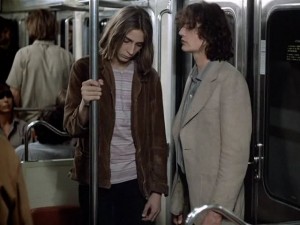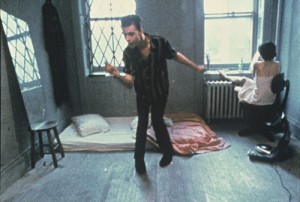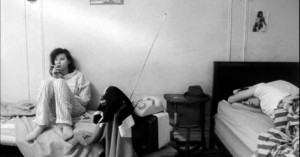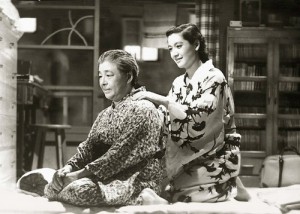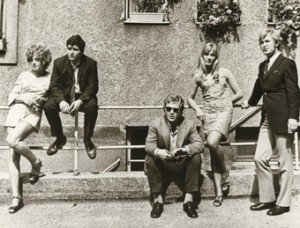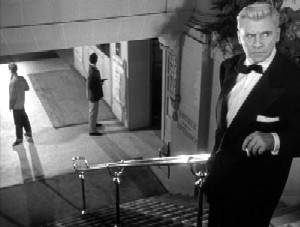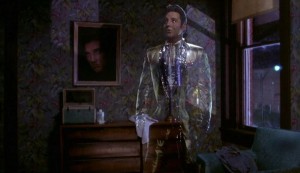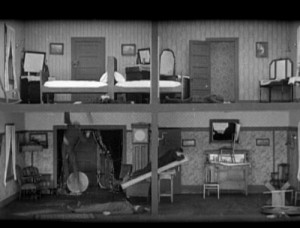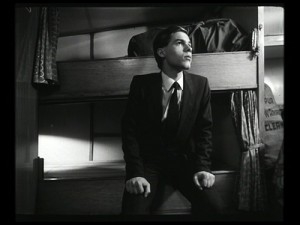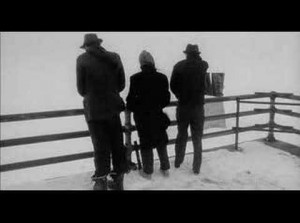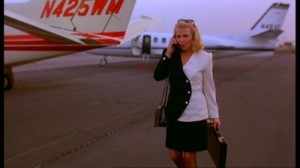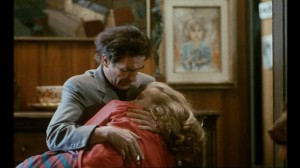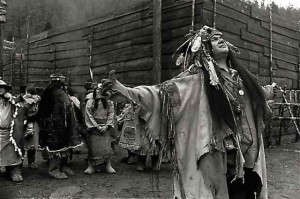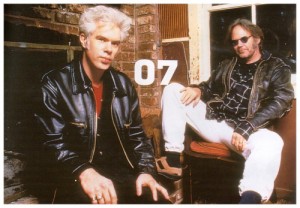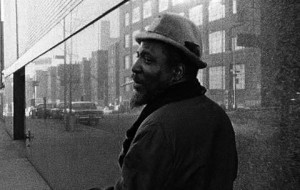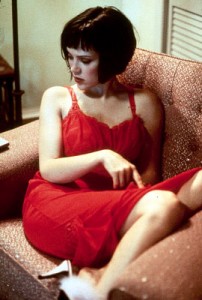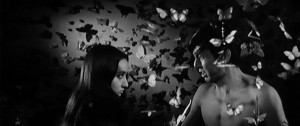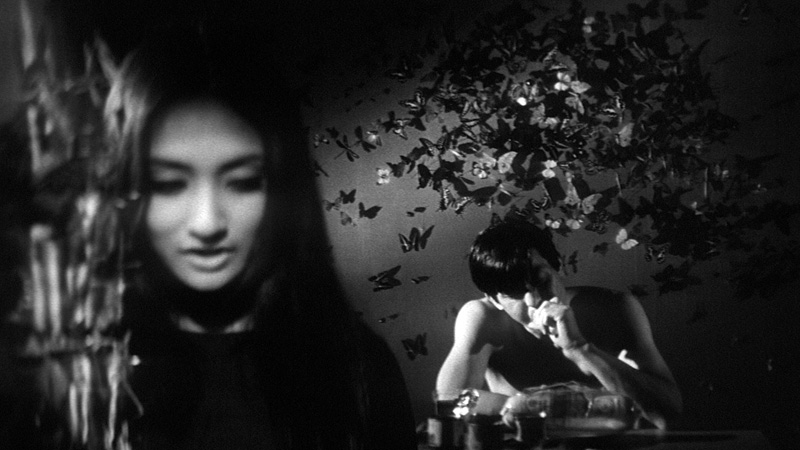Part of a booklet accompanying a Jim Jarmusch retrospective at the Wexner Center for the Arts at The Ohio State University, October 2001. -– J.R.
A child of the New Wave who spent time at the Paris Cinémathèque, was Nicholas Ray’s personal assistant on Lightning Over Water — and Sam Fuller’s costar in Tigrero [Mika Kaurasmaki] many years later — Jim Jarmusch has loved films even longer than he’s been making them. Signs of this love are fully apparent in his tributes to John Cassavetes, Fuller, and Robert Mitchum, as well as in a recent phone conversation I had with him about his selections of favorite films by others to accompany his own films at the Wexner Center.
J.R.
I want to focus mainly on the pairings you’ve come up with. Why, for instance, show The Devil, Probably with Permanent Vacation, your first film?
I don’t really know. I saw The Devil, Probably a long time ago, and I’ve never seen it since. I remember it being about a young guy in Paris who’s suicidal. And it’s [Robert] Bresson. Before I saw this movie, when I used to go to Paris, I’d sit at the end of Île de la Cité, and I think that’s where the film ends.
But I had other ideas: The Foreigner, Amos Poe’s film, in a way inspired me to make Permanent Vacation. He made that film all on the street, with no money, guerilla-style. I thought of [Wim Wenders’s] Kings of the Road. And, you know, there’s a genre of film which l call walking-around guy movies, like [Roberto] Rossellini’s Germany Year Zero — and this reggae film called Rockers by Theodoros Bafaloukos.
I remember a reference to Nicholas Ray in Permanent Vacation.
Yeah. The hero’s in the lobby of the St. Marks Cinema — a third-rate house which l was able to shoot in because l was an usher there at the time — and there’s a poster of The Savage lnnocents, which Susan Ray loaned me. He asks the girl selling popcorn about the movie….Nick Ray made many of my alternative choices for this series: The Lusty Men, They Live by Night, In a Lonely Place, On Dangerous Ground. And Jacques Rivette made at least two: Celine and Julie Go Boating and Paris Belongs to Us.
Next comes Stranger Than Paradise and Tokyo Story.
I really wanted to show a [Rainer Werner] Fassbinder film, Katzelmacher, but they’re already showing it in another series at the Wexner. I didn’t see it until after I made Stranger. It’s about a foreigner coming to Germany to work, and Fassbinder played that character. It’s in black and white, and a lot of scenes are shot in a single setup.
You might call it a standing-around guy movie. They’re all lined up on the street.
Yes. And there are these beautiful tracking shots that follow characters walking towards the camera….But [Yasujiro] Ozu is a classical master and one of my favorite film directors. His simplicity and the purity of his style continue to be a big inspiration to me. I thought of Tokyo Story, Late Spring and one that’s not seen much, The Flavor of Green Tea Over Rice. In the first third of Stranger Than Paradise, when we meet the Richard Edson character, there’s a scene where they talk about horse racing. He’s reading off names of horses on a racing form and they’re all titles of Ozu films.
Stranger is often a movie about people sitting around rather than walking around or standing around. So Ozu seems appropriate….Then with Down by Law there’s Bob le flambeur [Jean-Pierre Melville].
Yeah. I don’t know why, it’s just a film I love, and I know there’s a new print.
There’s the theme of camaraderie.
Yeah, and people on the outside of things who keep their little social niche. But the central character is so elegant in Bob le flambeur and I wouldn’t say the characters are elegant in Down by Law.
I had a lot of other ideas. I thought of the film that I first saw [Mystery Train]’s Youki Kudoh in, called The Crazy Family [Sogo Ishi], a Japanese comedy. Oddly enough, the only time I’ve been on a jury at a film festival, that film was shown. And I met Roberto [Benigni] — he was on the same jury. I also thought of the first film he was in as an actor — which I hadn’t seen until after l made Down by Law: Berlinguer I Love You (Berlinguer ti voglia bene) by Giuseppe Bertolucci. I don’t think it’s ever been subtitled in English. It’s really funny and strange; it has Alida Valli in it playing Roberto’s mother. And I thought of Roberto’s first film as a director, You Bother Me (Tu mi turbi) — an episodic film with four sections. I don’t think that’s been seen here either. I saw both of those films with Roberto sitting next to me translating. And his English was not real good at the time, but I got all the jokes.
I also thought of weird stuff like that Stanley Kramer film The Defiant Ones, where Tony Curtis and Sidney Poitier are chained together and escape from prison, and can’t stand each other; [Jean-Luc Godard’s] Band of Outsiders, which also would have worked with Stranger Than Paradise; Accatone, one of my favorite [Pier Paolo] Pasolini films; and Hell in the Pacific, the John Boorman film with Toshiro Mifune and Lee Marvin — just because it’s about two guys who have to reconcile a lot of heavy things. (Laughs.)
With Mystery Train you’re showing three shorts: Buster Keaton’s The High Sign, Robert Frank and Alfred Leslie’s Pull My Daisy, and an installment of your own Coffee and Cigarettes.
Coffee and Cigarettes is tentative, assuming we can get a print. It was the Wexner [Center’s] suggestion. I thought of films that were trilogies or episodic, like Paisan [Roberto Rossellini] or Kwaidan [Masaki Kobayashi]. But we’re showing The High Sign — one of my favorite Keaton films, and not well known — and Pull My Daisy, which I love, both formally and for the spirit of it. The Keaton is good to see on a big screen, the way it was intended — especially the gag at the end with the cutaway house. But they really don’t have anything to do with Mystery Train.
Sometimes there are connections when you’re least expecting them. About 20 years ago, in a retrospective I was programming in New York, Jean-Marie Straub and Danièle Huillet decided to pair their own short, Every Revolution Is a Throw of the Dice, with Charlie Chaplin’s A King in New York. And it turned out to be perfect, because the Chaplin film starts with a revolution.
That’s another thing that’s missing, Straub and Huillet. I can imagine showing their Class Relations with Stranger Than Paradise. You know, the black transitions in Stranger were made out of film stock that they gave me, left over from Class Relations. And the remaining footage was on unexposed stock left over from [Wim Wenders’s] The State of Things. I can’t believe they gave me all that stuff.
Yeah — that was from the last great era of black and white.
You mean it’s over now? (Laughs.) Don’t tell me that. I just made a short film this year in black and white.
Now we’re up to Night on Earth and Love Streams. And the obvious link here is Gena Rowlands.
It’s just a movie that I love so much that I’d like to show it, and this is the obvious place for it. And Gena does provide a connection. You know, when it first came out I went to the theater and saw it twice in a row. I’ve only seen it once since then, on video.
It’s become my own favorite [John] Cassavetes film. I’ve just seen it again recently, and it gets better all the time. And it’s tied to my other favorite Cassavetes film, Shadows, which is also about brother and sister.
I thought of Shadows too, and also Faces, as films that could be shown with Stranger. Unfortunately, most of the films I’ve picked are going to blow my films away. But what can you do? Too late now. (Laughs.)
The one you have with Dead Man is another particular favorite of mine, Howard Hawks’s The Big Sky. What made you think of it? I know you’re fairly critical of the way Hollywood generally shows Native Americans.
Yeah. In a way you kind of convinced me when we talked earlier, though it was one of my suggestions. It’s a voyage film, and the way it takes characters through those landscapes — even the title refers to that — is kind of amazing. But this was a hard category because I had a lot of wacky ideas. First of all, I thought of [Andrei Tarkovsky’sl Andrei Rublev — l don’t know why, because it’s so expansive and incredible. Then I thought of other westerns I like a lot: McCabe and Mrs. Miller [Robert Altman], the Robert Wise film Blood on the Moon with [Robert] Mitchum, Monte Hellman’s The Shooting and Ride the Whirlwind, Heaven’s Gate IMichael Cimino]. And Pow-wow Highway [Jonathan Wacks] — the first time I saw Gary Farmer on screen — which I would recommend people seeing. I thought of Cheyenne Autumn; one reason was because of the really bizarre cast. I would have some problems, again, with how Native people are depicted in that — and that’s the most gracious film of [Johnl Ford’s on that level. I have problems of that kind with The Big Sky — their transporting of an Indian princess.
But one thing that makes it an apt choice for me is that The Big 5ky is such a mysterious film, as I think Dead Man is. Compared to most westerns, they somehow have a different relation to period; it’s almost as if they were both taking place during the Middle Ages.
Yeah, well, in The Big Sky they’re sort of trapper guys. It’s not a western where the guy cleans up the town and marries the schoolmarm.
They’re both very much about the wilderness.
Yes, and for me the landscapes in Dead Man are almost like characters in the film.
So, next is Year of the Horse and Thelonious Monk: Straight No Chaser [Charlotte Zwerin].
That was a tough one, too, because my favorite rock-and-roll movies are Don’t Look Back [D.A. Pennebaker], which is pretty well known, and Cocksucker Blues [Robert Frank], which is unavailable. I like This Is Spinal Tap [Rob Reiner], of course, but I think of Year of the Horse formally as more like Monterey Pop [D.A. Pennebakerl. There’s also Gimme Shelter [Albert and David Maysles, Charlotte Zwerin]. But I’m such a Monk fan, and Straight No Chaser is such a beautiful portrait of Monk — l thought, that’s another movie that would be great to see on a big screen.
Apart from Point Blank, my favorite John Boorman film, I had two choices for films to go with Ghost Dog: Melville’s Le samourai and [Seijun] Suzuki’s Branded to Kill. And since we were already showing Melville’s Bob le flambeur, I picked Branded to Kill. Those two are my favorite oddball hit-man movies, and Le samourai is an obvious inspiration. Branded to Kill borders on surrealism at times — a very strange film, very stylized. And I took several things from it directly, the most obvious of which is shooting someone up through a drain pipe. (It’s really more elaborate in Branded to Kill.) And there’s another scene where he’s attempting to assassinate somebody and his sights on a rifle are blocked by a butterfly. In Ghost Dog it’s a bird. There’s a lot of strange bird and butterfly imagery in Branded to Kill.
You even showed Ghost Dog to Suzuki, didn’t you?
Yes, I did. And Suzuki told me through a translator, “Ah, you have stolen from me. Now, in the film I’m planning, I would like to steal from you'” And he laughed. He told me the story of the film — which I’m afraid no one is financing — and swore me to secrecy. It was amazing. [2013 postscript by J.R.: It’s possible that this may have become Pistol Opera, Suzuki’s next feature.]
He really made his name in second features, didn’t he?
He was a B-movie director and then he got too strange.
Sort of what happened to Sam IFuller], right?
Yeah, very similar. Although the style of Sam is more visceral.
There’s a kind of crazed humor in both of them.
Yeah, and the characters are almost obsessive in their passions. They both come out of crime movies. But Branded to Kill, it’s very important to see that on a big screen. It’s in ‘Scope and it’s beautifully photographed. It is available on video in the United States now and the video sucks. It is really not a good transfer. It’s the same with [Suzuki’s] Tokyo Drifter. So if you can see Branded to Kill on a big screen, it’s a real experience.

